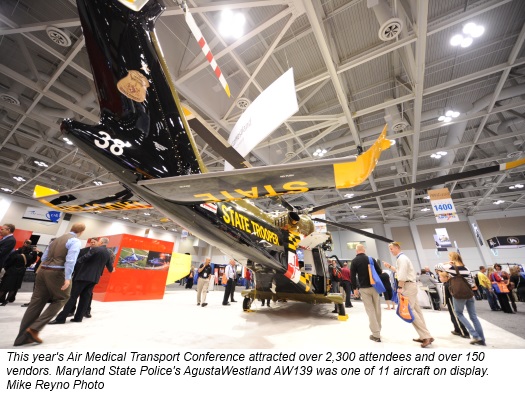
The Air Medical Transport Conference (AMTC) was brought to a successful completion on Wednesday, after three days of vendors exhibiting their wares, well-attended education sessions on a full spectrum of air medical topics, and various networking opportunities and events that took place each evening.
Over 2,300 air medical industry members attended the event, held this year in Virginia Beach, Va., from Oct. 21 to Oct. 23. The bustling exhibition hall played host to 11 emergency medical services (EMS) -equipped helicopters and over 150 vendors — as well as the ever-popular CAE Cup Competition, where 10 teams went head to head in a critical care skills event utilizing the latest in human patient simulation. The keynote address was given by retired four-star U.S. Army General and former Director of the Central Intelligence Agency, David Petraeus, who spoke about his own experiences with air medical transport after he was shot during a live training exercise in Fort Campbell, Ky.
“What you do is literally life changing, life saving, and of the greatest importance,” he told the audience via live videolink (an unexpected international commitment had prevented his visit to the conference in person). “This is a group whose members truly do carry out the Lord’s work if you will. You really are angels to those who are injured seriously, whose lives often are at stake and who have to get to the hospital in what we termed the golden hour in the military.”
Major developments during the three-day event included Metro Aviation’s disclosure of more details regarding the expansion of its newly-named Helicopter Flight Training Center; the announcement of several HEMS-related orders for the major original equipment manufacturers; and the presentation of the AMTC’s annual awards — with the Program of the Year Award going to UC Health’s Air Care & Mobile Care.
Metro Aviation president Mike Stanberry held a special announcement on the second day of the conference, during which he revealed that FlightSafety International had been chosen to provide the flight simulators for Metro’s Flight Training Center in Shreveport, La., and that the first — a Eurocopter AS350 Level 7 flight training device — had already arrived, and would be in operation in early 2014. The second sim, a full motion Level D Eurocopter EC135, is due to join Metro in the second quarter of 2014, while a third sim — the world’s first Eurocopter EC145 Level D full flight simulator — is being developed, with Stanberry saying he hoped it would take 12 to 18 months to complete.
CALSTAR and Med-Trans were also revealed as the launch customers for the EC135 and AS350 simulator training.
Eye-catching displays included Air Methods’ introduction to its vision of the future of critical care access, delivered via a self-guided audio tour around the booth, with different stations revealing anticipated and actual developments in telemedicine and virtual health technology.
Keynote address
In giving the keynote speech to the assembled crowd of air medical industry professionals, Petraeus spoke of the training ground incident that almost claimed his life, when he was a Lieutenant Colonel and Battalion Commander in Fort Campbell. A trooper was emerging up the steps of a bunker with an M16 rifle during a live fire exercise when he tripped and fell hard, accidently squeezing off a round as he hit the ground. “It went right through my chest. . . . I had the classic sucking chest wound,” said Petraeus. “In case you’ve never had a round go through your chest and go out your back, if feels as if you’ve been hit from behind, actually — by the world’s largest sledgehammer. It’s quite an enormous blow.”
It turned out that his artery had been nicked by the bullet, but thanks to the quick actions of field medics on the scene, and a rapid response by a medevac helicopter, he was soon being treated in the field hospital. There, the doctor attended to Petraeus’ internal bleeding before sending him on to Vanderbilt University Hospital, where the surgeon that would operate on him was a young Bill Frist — who would go on to serve as Majority Leader in the Senate after entering politics.
“The fact is, it was a medevac bird that enabled all of that, and it did in fact save my life,” said Petraeus.
Addressing a key topic for the air medical transport sector, he commended its members for voluntarily driving improvements in safety systems and operations, such as the implementation of night vision goggles, flight data monitoring equipment and terrain warning and collision avoidance warning systems in operations.
Finally, he discussed the importance of sharing lessons learned in battlefield medicine and those learned in emergency trauma in the civilian world; an exchange of information he said flowed both ways, and allowed for improved life-saving service in both military and civilian medical emergencies.
“I’ve often said that the most important ‘Army of One,’ as we used to use the term, is that medic who’s peering down into your eyes as he tries to get an IV started, or the medevac pilot who’s speeding you to the hospital,” he said. “I want to thank you very sincerely for what each and every one of your does, each and every day that you’re out there as a medical evac person. Thank you very much.”
Next year’s AMTC will be held in Nashville, Tenn., from Sept. 22 to 24.









